Manufacturers
Among the recognized firms producing floor convectors are Russian, in particular, the Breeze model. Depending on the power, modifications are produced with natural convection and with a tangential fan. The heat exchanger is made of copper-aluminum alloy, and the grill is made of duralumin. The temperature of the coolant can reach 130C, and the operating pressure is 15 atm.
Floor convector "Breeze"
The EVA collector designed for heating small rooms is also known from domestic products. The use of stainless steel parts, modern manufacturing technologies and the ability to independently select a complete set make this heating option widely in demand. It all depends on financial capabilities and taste.
Water convectors "Kermi" (Belgium) are very popular in terms of a wide choice and high reliability. They can be used as main heat sources. The low body height makes it easy to install floor convectors that can be built into any floor. The range of sizes and capacities of the products is large, and the warranty is 10 years. They are equipped with thermostats and can work autonomously. The fans are powered from a 12V source. Manufacturers make floor-to-ceiling water convectors to order.
High quality and reasonable prices made the Czech brand "Minib" popular in Russia. Convectors reach maximum power in 10-15 minutes. If we compare them with radiators, then this takes 30 minutes.
It should also be noted the popularity of the German "Varmann" convectors, where the latest innovations are applied, which do not significantly affect the final cost of the models. The range of products is highly versatile. They are made in straight and semicircular shapes, in the form of corner structures or passing through columns.
The principle and structure of water convectors
Classic radiators heat walls and surrounding objects, thereby heating living quarters. In order to increase efficiency, they are made with ribbing, which creates a convective air flow. As a result, the heating rate of private houses and apartments is increased. Heat is delivered to radiators using a heated coolant - most often it is ordinary tap water. It enters the room through convection fins and in the form of thermal radiation.
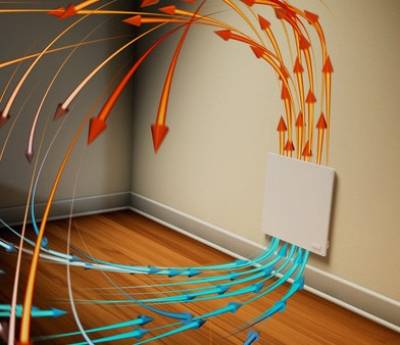
The principle of convection is very simple - heated air rises, and cold air comes in its place.
Convection is good in that it provides quick heating of any type of room. Heated air masses, rising to the ceiling, displace cold air from below, forcing it to pass through the convectors. Thanks to this, the results of the operation of the heating system become noticeable literally half an hour after turning on the heating. At the same time, a classic heating battery cannot boast of similar results.
The principle of operation of water heating convectors is very simple. The heat carrier flowing through them heats the steel fins. As it heats up, it tends upward, and the next portion of air enters its place. Pure laws of physics work here, providing high-quality heating of living quarters. The heating procedure is carried out absolutely silently, without disturbing the household.
Some water convection heaters have built-in fans that allow you to organize forced convection in order to heat the premises faster.
How are water heating convectors arranged? Inside them we will find:
- steel or copper pipe - a coolant flows through it;
- ribbing - it is responsible for heating air masses;
- connection nodes - with their help, the devices themselves are connected to the water heating system.
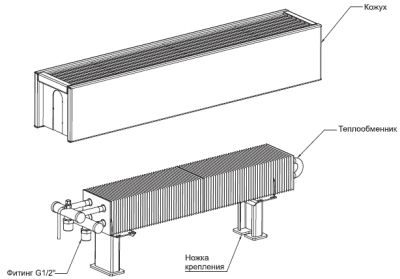
As you can see, there is nothing complicated in the device of this device: a heat exchanger with connection nodes, closed by a case.
Additionally, thermostats and air deflectors are installed - the former allow you to adjust the degree of heating, and the latter serve to remove air from the heating system. The device of convectors is very simple, and their diminutiveness will not spoil the interior of living or working premises.
The scope of application of water convector heaters is extremely wide. They are used to heat private households, apartments in apartment buildings, office, administrative and industrial premises. Here is a list of their benefits:
- such heating devices provide quick warming up - in terms of the heating rate, they outperform conventional batteries;
- high efficiency - the heaters themselves give off more than 95% of the incoming heat to the air masses;
- compactness - due to their small size, these heaters can be used in rooms with panoramic glazing without spoiling the appearance.
This is a universal heating equipment for any premises.
Caring for heating convectors is very simple - they need to be periodically cleaned of dust that accumulates on the finning elements. This is where a vacuum cleaner comes in handy, providing good suction. Outside care comes down to simple dust removal with a damp cloth. Internal cleaning is carried out at least a couple of times a month, which prevents the accumulation of a large amount of dirt.
Lack of proper care of heating devices will lead to the accumulation of a large amount of dust - natural convection will spread it throughout the room, which will not add health to allergy sufferers.
Rating of the best floor convectors in terms of operational and technical parameters

As already noted, the most popular today are water floor convectors. They are divided into two large groups - forced and natural ventilation.
The difference between them lies in the presence of a special fan designed to increase the level of air convection in the room. Obviously, it is advisable to determine the best floor convectors for each type separately.
Natural circulation water radiator
A natural circulation heating system has a simpler design and, as a result, a slightly lower cost.
Among the large number of models of such equipment on the market, the products of four manufacturers stand out, producing the best floor convectors with natural circulation.
These include:
1. Technoheat. Deservedly considered one of the most popular brands of heating equipment in Russia. Among the main advantages of products manufactured under the Technoheat trademark is a combination of a high level of reliability and quality with an affordable cost and a variety of models. The most popular are water convectors KVZ, which are manufactured in several standard sizes.
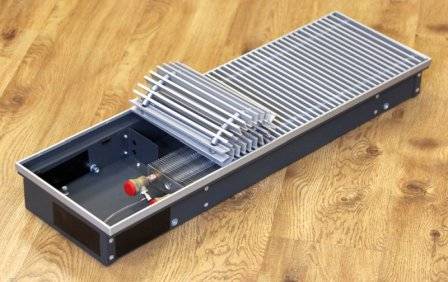
2. Eva. A popular domestic manufacturer that has been successfully operating on the Russian market for a long time. The company manufactures various types of convectors, including wall-mounted, trenchless and floor-mounted. Among the main advantages of the equipment produced is a reasonable price, which is complemented by good operational properties.

3. Kermi. The Czech manufacturer is one of the most prominent participants in the Russian heating equipment market, producing an extensive range of various radiators and other types of heating devices.Underfloor convectors from Kermi are also in significant demand, slightly inferior in some indicators to the products of the manufacturers supplied in this list above.

4. Mohlenhoff. The traditional and well-known German quality did not allow this brand to take a higher place in the ranking of the best floor convectors for one simple and quite logical reason - a higher cost compared to competitors
At the same time, it is important to note that in most other parameters, Mohlenhoff products are not inferior to products from other manufacturers listed in the rating.
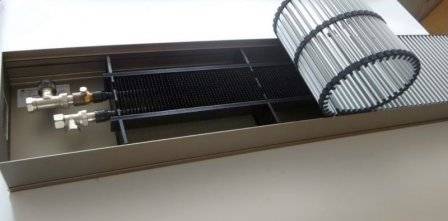
Forced convection floor radiator
A heating system using floor-mounted forced convection radiators includes one or more fans. Their number is determined by the dimensions of the convector and the requirements for the performance of the system.
Such heating devices cost the building owner much more expensive, but have increased heating efficiency parameters.
Among the most popular floor-standing radiators with forced convection, it is necessary to highlight the products of the following companies:
1. Technoheat and Mohlenhoff. It is extremely difficult to single out the undisputed leader in this category of heating equipment. The fact is that the manufacturer from Germany occupies a leading position in the premium segment of floor convectors, while Technoheat dominates among relatively inexpensive and budget models. Among the latter, it is necessary to highlight KVZV and KVZV-TX, which are in high demand in the domestic market.
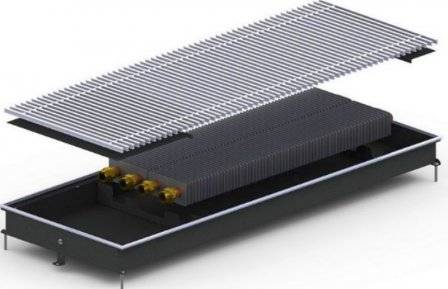
2. Breeze. A well-known Russian manufacturer whose products directly compete with the currently more popular Technoheat brand. Among the advantages of heating equipment from the "Breeze" company are the variety, affordable cost and excellent design of products.
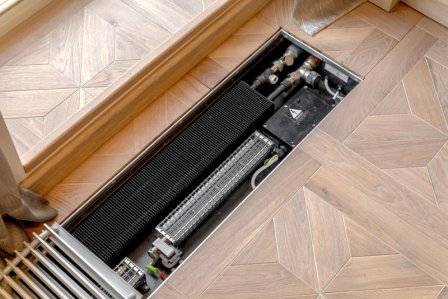
3. Minib. Another manufacturer from the Czech Republic, whose trademark, along with Kermi, is one of the most recognizable floor convectors on the Russian market. Among the main advantages of Minib radiators are European quality and excellent performance parameters.
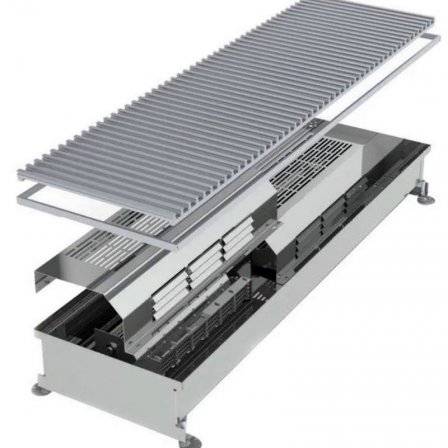
The main criteria for choosing the best floor convector

In order to determine the best floor convectors, it is necessary to establish criteria that will help you make the right choice.
At the same time, it is extremely important to understand the main advantages of radiators built into the floor, since how effectively they are implemented in a specific model from a specific manufacturer is the main argument to rank this heating device among the best
Advantages of water floor convectors
The most important advantages of floor convectors include the following characteristics, which will become the main criteria for determining the most efficient heating devices:
saving room space;
the ability to use in combination with panoramic glazing, which is popular today;
reducing the cost of finishing the premises;
the efficiency of the heating system operation;
giving the interior a stylish and modern look;
versatility, allowing the use of floor convectors in buildings of various types - residential, public or commercial.
The listed advantages, characteristic of radiators built into the floor, should be considered first of all when it is necessary to get an answer to the question of which floor convectors are better.
In this case, in most cases, it is advisable to take into account only water radiators, since electrical heating devices have a very limited scope and are noticeably inferior in most performance indicators
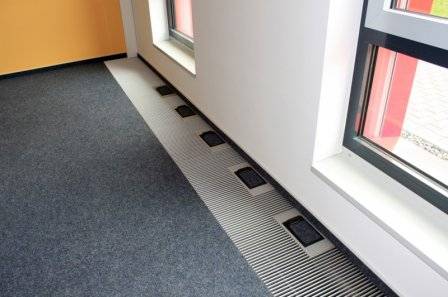
Disadvantages of floor-mounted radiators
In order to highlight the best water floor convectors from the many on the domestic market, it is important to study not only their positive qualities, but also their disadvantages.Their number is not so large, nevertheless, serious manufacturers of heating equipment have long learned to reduce the disadvantages of radiators built into the floor to a minimum.
Their number is not so large, nevertheless, serious manufacturers of heating equipment have long learned to reduce the disadvantages of radiators built into the floor to a minimum.
Among the most significant disadvantages should be noted the possibility of dust accumulation and the difficulty in identifying leaks.
The first disadvantage has nothing to do with the characteristics of a particular convector model and is eliminated by regular regular measures to maintain cleanliness in the room.
To minimize the possibility of leaks, it is required to purchase products from trusted manufacturers, which are characterized by a high level of reliability and quality.
In addition, it is necessary to regularly inspect the operated convectors, which will allow you to quickly identify possible problems.
Advantages of water heating convectors
- Modern water convectors are more efficient and economical than conventional radiators. The following advantages can be highlighted:
- The principle of convection is used. The air is heated, not the device case (as in conventional radiators). As a rule, the case is heated to a temperature of no more than 40-45 ° C, which allows them to be used in kindergartens without a protective wooden casing, as is the case with cast-iron radiators. The child will not be able to get burned by touching the body of the device.
- High heat transfer with low energy consumption.
- Resistance of materials to corrosion. For the manufacture of high quality water heating convectors, copper, aluminum and stainless steel are used. This allows them to be placed in rooms with high humidity.
- Compactness of the heating system and low weight.
- High speed of heating the room.
- Does not dry the air.
- The presence of a thermostat allows you to regulate the temperature.
- Unique design and high quality of heating devices and components.
Kampmann Katherm NK.
Floor convectors heating - their design
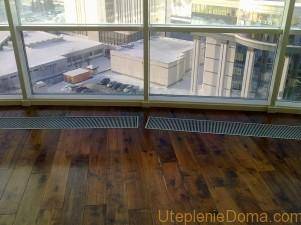
Floor convectors for hot water heating can significantly save energy.
This is a heating device consisting of a copper-aluminum tube through which a coolant circulates. Since water heating elements are considered, water passes through the tube. The heat exchanger can have both round and rectangular cross sections. Steel, aluminum or galvanized steel plates are attached to it in a perpendicular plane. They increase the convector's area and improve its heat exchange with the environment. Due to their large volume, convectors quickly respond to the temperature of the coolant, therefore, they contribute to the creation of a pleasant microclimate in the room.
They can have an angular or radial shape, bend around columns with their bodies or go into a niche, differ in non-standard length. But their main advantage is that they are not visible, as they are completely hidden in the floor. Only the decorative grille remains outside. Air exchange is carried out through it.

One of the advantages of these convectors is that they are installed in the floor and cannot be seen.
Today there are convectors with natural and forced draft. In the first case, cold air descends to the heater, since it has a high density. As it heats up, its density becomes less, which allows it to rise upward and displace the colder gas. Forced circulation floor convectors are equipped with built-in fans. Depending on the size of the device, there may be one fan or there will be several of them. They artificially inject air into the space near the heater, thereby increasing the percentage of room heating.They are low-power, therefore they practically do not emit any noise during operation. The fans can operate both from AC with a voltage of 220 V and DC with a voltage of 24 V, which makes it possible to regulate their rotation frequency, thereby controlling the air flow passing through the device.
Underfloor heating convectors are mounted in a niche, the coolant is connected to them using a flexible connection, that is, this makes it possible to mount the device in any convenient place, regardless of the location of the boiler or the supporting (main) pipe of the water heating system. It should be borne in mind that the operating pressure in the system for the water heating element must be 10 bar, and the test pressure must be 25 bar.
Floor convectors heating: what is it

In a few words, the device can be described as follows: if panoramic windows from floor to ceiling are planned in your house or apartment, built-in convectors are your version of the heating system.
Because there will be no place to install traditional radiators and even conventional convectors.
However, in any case, built-in convectors benefit, even with standard windows and a room layout: with this system you are guaranteed a high aesthetics of the interior.
Design features
The floor convector is a built-in channel in the floor, a box made of corrosion-resistant steel. Copper piping and an aluminum heat exchanger are located inside the box. From above, everything is covered with a decorative grill.
By design and principle of operation, these devices are divided into two types:
- With natural convection, when, due to the density difference, warm air is replaced by cold air inside the device.
- With forced convection, the device is equipped with a centrifugal or tangential fan. Thanks to this, the air is distributed more evenly through the heat exchangers, it warms up faster, which contributes to the rapid heating of the room.
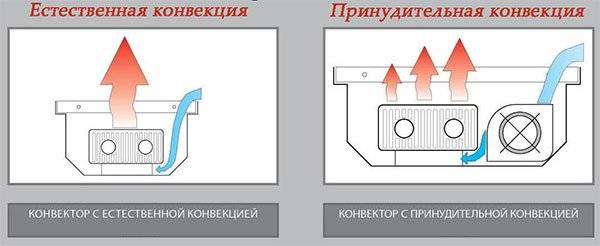
Photo 1. Scheme of operation of an underfloor heating convector with natural (left) and forced (right) convection.
Principle of operation
Built-in convectors are installed in the floor around the perimeter of the room, focusing on the lines along the windows. Actually, first of all, they are intended for the installation of this heating system.
The principle of operation is based on the fact that low-temperature air naturally descends into the convector from the cold conductor window, warms up in the convector and is pushed into the room by a new flow of cold coming down from the window.
Advantages of floor recessed products
Aesthetics is an indisputable plus of underfloor heating devices. You must admit that decorative grilles in the floor, from which warmth emanate, create much more comfort than bulky batteries.

- The space is freed up that is not occupied by the usual radiators, plus we get free access to the windows and doors of the loggia or balcony.
- The heat from the convector goes exactly where it is coldest - along the windows and doors.
- The room heats up much faster than with a classic heating system.
- The equipment is lightweight and does not place stress on the foundation and floor.
- The decorative grill temperature does not exceed +40 ° C. Impossible to get burned.
- The floor convector not only heats up the room, but also cools it down, replacing the air conditioner.
disadvantages
- The need for proper care of the device. We will dwell on this in more detail later. We only note that sometimes it is also necessary to brush off dust from traditional cast-iron radiators. So this disadvantage is relative.
- Cost - devices are not cheap, especially if they are equipped with additional equipment.
Attention! Incompatibility with a classic heating system - they cannot be mounted with each other. Without going into technical nuances: neither one nor the other will work normally
Having decided to equip the room with floor convectors, carefully weigh the capabilities of the system in relation to the building that needs to be heated.
The complexity of installation - you will need the services of a specialist if you are not a self-taught technical genius.
Types of water heating convectors
Intra-floor
They are used for heating office premises and private houses. Radiators are built into the floor (copper-aluminum heat exchangers are used), while the room is heated by natural air circulation (convection).
Floor convector.
Also suitable for heating museums, winter gardens, swimming pools, greenhouses, that is, those premises where a special microclimate is envisaged.
Floor standing
Several floor-standing radiators are placed along the perimeter of the room, connected in parallel.
Kampmann Katherm.
Due to natural circulation, warm air is released and evenly distributed around the entire perimeter.
Note! Some models come with a durable surface, making them suitable for benches in gyms and cinemas.
Wall mounted
This is the most popular type of convectors.
Wall-mounted water convectors are compact and can be placed directly under windows or in niches. The use of such heating devices allows you to create comfortable conditions in rooms with panoramic windows and winter gardens.
Skirting boards
The skirting-type water convector is a novelty of heating equipment, which is designed taking into account all the requirements for modern heating systems and makes heating comfortable and economical.
Warm plinth for water heating, 1 m long, consists of a copper-aluminum heat exchanger and a casing (profile). The convectors are connected to each other by soft soldering.
The system is equipped with a thermostat with a sensor (to regulate the heat flow).
Basement
Such a heating system can be called invisible, basement convectors are mounted in walls, steps, under windows and even in furniture. This arrangement allows you to "save" the usable area in the room, while the heating device becomes almost invisible (it can be seen only by the grate in a special niche).
Thanks to the built-in fan, the room is heated at the required level and evenly.
Water convectors in one of the rooms of the hotel under construction. Connection via Uponor XLPE pipes.
Types and characteristics
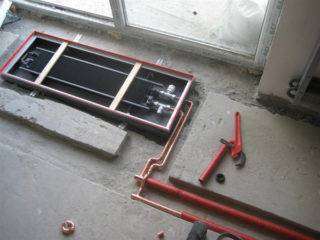 Water convector
Water convector
Convectors can be built into the floor or installed on top. Water and electrical appliances are emitted depending on the heat source.
Aquatic
The water-type device is a galvanized steel box, in which a heat exchanger is placed in the form of a U-shaped tube. The radiator is built into the channel, which is previously made in the subfloor. From above it is covered with a decorative grill.
The air heats up and rises to replace the cold masses. The media temperature rises to 900 degrees. Heating power can be adjusted using the built-in fan. Thanks to temperature sensors, the fan is automatically turned off or the rotation speed changes.
Since the body of the water radiator is built into the floor, there are no special requirements for its design
Particular attention should be paid to the quality of the metal. If there is high humidity in the room, the case must be made of stainless steel
For dry rooms, galvanized steel can be used.
Heaters are used in the following cases:
- in public premises of institutions, private houses;
- in places where it is not possible to install radiators.
It is also a good option for organizing heating in swimming pools.
Electrical
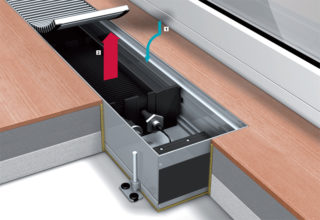 Electric underfloor heater
Electric underfloor heater
Electric convectors can be operated without installing fans. They are equipped with special ventilation elements. Models with fans are installed in rooms where heating costs are very high.
Electric floor convectors have the following advantages:
- compact size;
- reliable steel body;
- silent work;
- economical power consumption.
The principle of operation is based on thermal convection. The disadvantages of such a system include the impossibility of installation in rooms with high humidity levels.
Water convectors heating
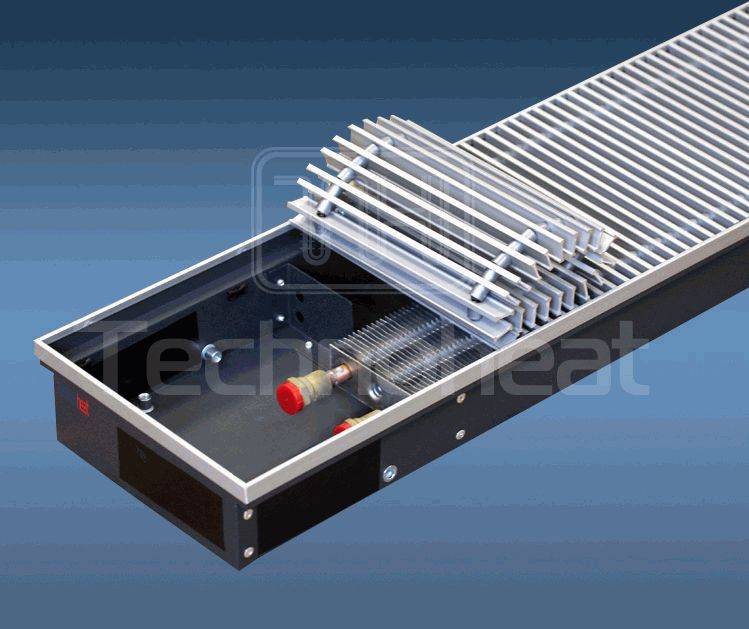
Width 200 mm, 250 mm, 350 mm, 420 mm.
Length 800 - 10000 mm.
Traditional heating devices are being replaced by new developments designed to provide a person with maximum comfort for minimum money. What is a water convector and what is their advantage over conventional radiator systems?
Water convectors are modern heating devices with a high efficiency factor and an ergonomic design. They can be used in autonomous and central heating systems.
Prices for water heating convectors built into the floor from Technoheat company
* Prices for water heating convectors built into the floor are indicated without a grill.
The underfloor heating water convector is one of the most popular today and is the only one of its kind: it does not take up extra space in the room, it will look the way the designer intended, and you can install the underfloor water convector as it is convenient for the customer, and not “ as necessary. "
Models from a domestic manufacturer are available today. Technoheat occupies one of the leading positions in the industry and presents a model range of its own design and manufacture. Our samples of floor water convectors are not inferior in quality to European counterparts, and in a number of technical characteristics they are superior to Western ones.
Floor heating convectors from Technoheat have:
- a universal case, which allows the fan to be built into a finished system;
- a wide range of models (various characteristics of heat transfer, options for overall dimensions, corner models of floor water heating convectors).
Advantages of water heating convectors built into the floor manufactured by Technoheat:
- Profitability. Significantly less energy is spent on heating a room.
- Speed. A water convector in the floor heats a large volume of air, which occurs in a short time due to the effect of forced convection.
- Aesthetics. A water heating convector built into the floor will perfectly fit into any interior.
Control the weather in the house
The water convector in the floor is ideal for creating your own microclimate. Our design department has created unique temperature control schemes that allow you to set automatic mode (there is a line of convectors with fans), or manually adjust the optimal heat transfer.
Trust the professionals
We carry out warranty service and replacement of parts in the shortest possible time and carry out qualified repairs of floor water convectors at a low price. Such conditions are possible due to the fact that the company produces everything necessary on its own equipment, and does not purchase from foreign manufacturers.
Convectors can be installed both in dry and damp rooms. To regulate the amount of heat, convectors can be equipped with manual or automatic control devices and integrated into the “smart home” automation system.
Price and quality
The quality of the water convectors in the floor from Technoheat and their price are the pride of the company. The indicators are in the optimal ratio and are much more advantageous than the prices for floor-standing water heating convectors of European production, taking into account their technical characteristics.
The entire model range and prices for water heating convectors built into the floor can be viewed in the catalog on our website or by making a request to send a price list to your mail.
Installation and connection of floor convectors
Let's take as an example the ideal option, when first a room is designed and erected, taking into account the subsequent equipping with built-in convectors, and only then we introduce them into the floor. Otherwise, it is definitely impossible to do without the help of specialists.
Mounting
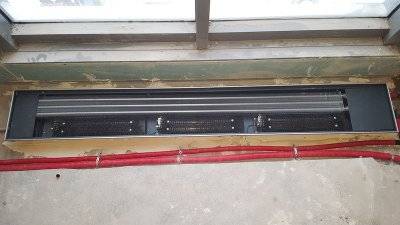
The first thing we do is prepare niches in the floor.
At the same time, keep in mind that the devices can be mounted not only in a concrete screed, but also in a raised floor - a wooden podium.
Niche depth. Instrument manufacturers recommend making it 10–20 mm higher than the convector height. This will level the box and dock it flush with the floor box. In terms of width and length, it is advised to add 5-10 cm from the dimensions of the box, so that it is possible to fix it well.
Reference. It is better to place the convector in a niche so that the heat exchanger is farther from the window and closer to the room - warm air will flow to its intended purpose faster.
- Distance from the window. Recommended - 5-15 cm for free air circulation. From the walls (if they are nearby) - 15-30 cm, so that excessive heat does not go to the walls.
- Curtains. At this point, manufacturers avoid answering how to combine this decorative element with a convector. We act logically: first, the heating system is mounted, and the curtain is adjusted to it so as not to impede air circulation.
- Heat loss and insulation. Make sure that the insulating material is always present. Otherwise, the convector will heat the floor nearby, and not the room.
Connection

If we are talking about a water convector, then there are two ways:
- Flexible connection - flexible hoses. These are easier to clean: you can simply lift the heat exchanger and eliminate dust and debris.
- Rigid connection - with a supply valve. It is more reliable, but less convenient to use.
The electric built-in convector is connected to a 220 volt network. The main thing: it is better to lay all the wires in advance, hiding them under the floor. It is absolutely unacceptable to put outside. In this case, the cross-section and material of the wire must correspond to the passport data of the convector.
It is better to entrust installation and connection to specialists.
How to choose a convector
The key criteria when choosing floor-mounted convectors will be two important points - the power and interior design features of the heated room. The first indicator can be found in the description of any model of the equipment in question and in the corresponding technical documentation included in the delivery set. This takes into account the characteristics of the room and potential heat loss.
Taking into account all the existing nuances, when deciding on the choice of one or another underfloor heater, it is necessary to take into account the following factors:
- system power is calculated taking into account possible heat losses in each room;
- the dimensions of the convector must be comparable to the dimensions of the niche in the floor in which it will be installed;
- each purchased unit of heating equipment must comply with the current GOST and be certified;
- it is necessary to make sure that the convector pressure test corresponds to the corresponding indicators of the entire system;
- taking into account the characteristics of the room, devices with a fan or with natural circulation of air flows are chosen.
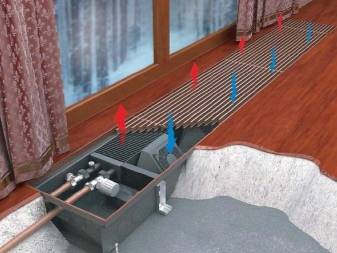
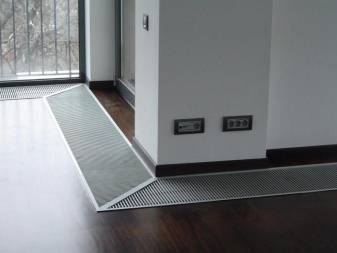
The most relevant heaters of the type under consideration are in situations in which the creation of an effective thermal curtain is required. Often such systems are installed in childcare facilities. This is due to their maximum safety and the absence of the risk of burns.
Power selection

To ensure a normal temperature in the living room, a natural circulation convector is perfect. If the rooms have high ceilings and a panoramic view, then it is necessary to purchase more efficient units with fans. The floor heating water convector must be selected taking into account the power. To do this, use the formula: 1 kW per 12 m2. In this case, the height of the ceilings should not be more than 2.7 m, and for every 10 cm of the area, 10% of the total power should be added.
